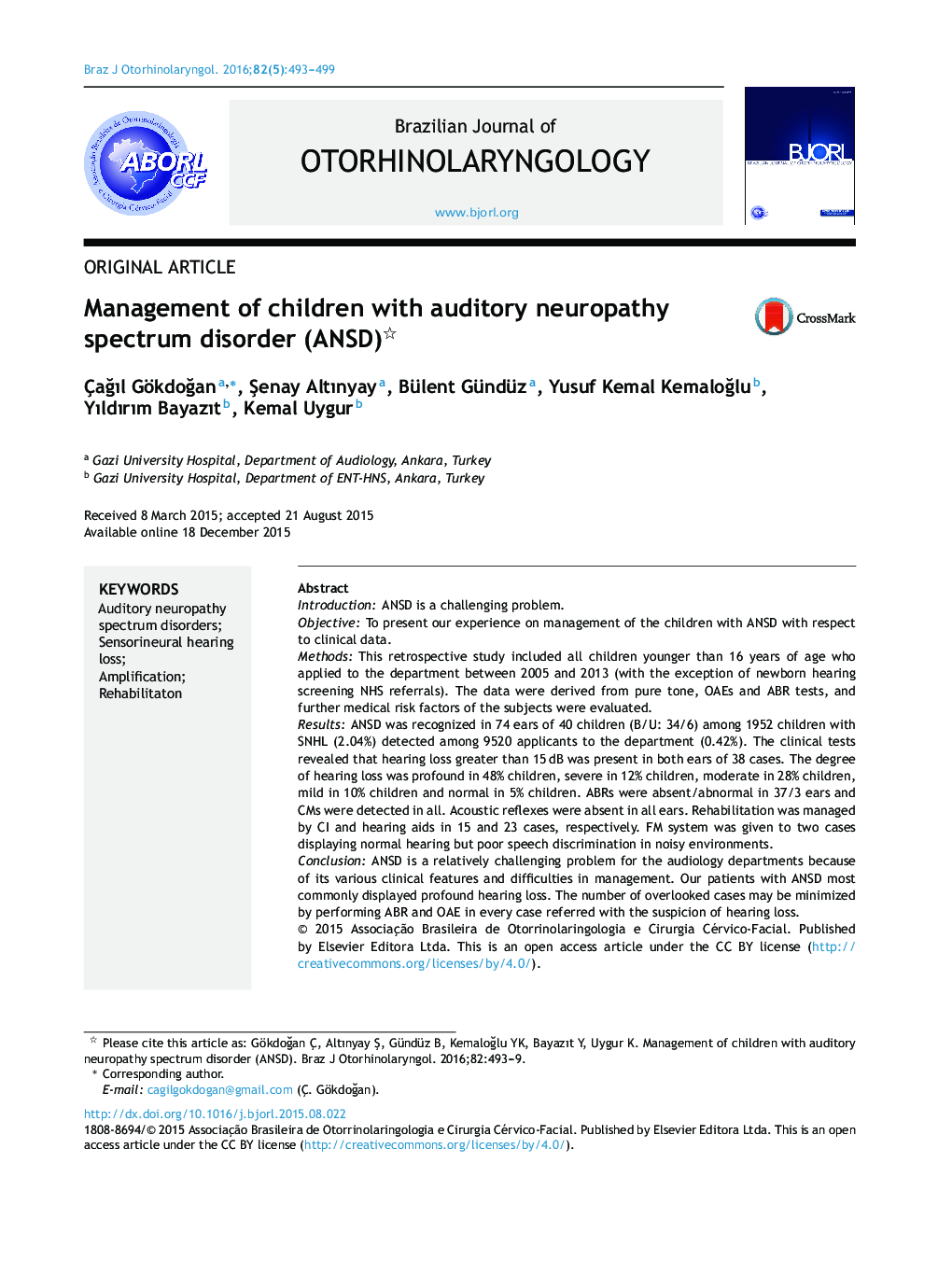| کد مقاله | کد نشریه | سال انتشار | مقاله انگلیسی | نسخه تمام متن |
|---|---|---|---|---|
| 4106052 | 1605359 | 2016 | 7 صفحه PDF | دانلود رایگان |

IntroductionANSD is a challenging problem.ObjectiveTo present our experience on management of the children with ANSD with respect to clinical data.MethodsThis retrospective study included all children younger than 16 years of age who applied to the department between 2005 and 2013 (with the exception of newborn hearing screening NHS referrals). The data were derived from pure tone, OAEs and ABR tests, and further medical risk factors of the subjects were evaluated.ResultsANSD was recognized in 74 ears of 40 children (B/U: 34/6) among 1952 children with SNHL (2.04%) detected among 9520 applicants to the department (0.42%). The clinical tests revealed that hearing loss greater than 15 dB was present in both ears of 38 cases. The degree of hearing loss was profound in 48% children, severe in 12% children, moderate in 28% children, mild in 10% children and normal in 5% children. ABRs were absent/abnormal in 37/3 ears and CMs were detected in all. Acoustic reflexes were absent in all ears. Rehabilitation was managed by CI and hearing aids in 15 and 23 cases, respectively. FM system was given to two cases displaying normal hearing but poor speech discrimination in noisy environments.ConclusionANSD is a relatively challenging problem for the audiology departments because of its various clinical features and difficulties in management. Our patients with ANSD most commonly displayed profound hearing loss. The number of overlooked cases may be minimized by performing ABR and OAE in every case referred with the suspicion of hearing loss.
ResumoIntroduçãoEspectro da neuropatia auditiva ainda é uma condição clínica desafiadora.ObjetivoApresentar nossa experiência no tratamento de crianças com espectro da neuropatia auditiva em relação aos dados clínicos.MétodoEste estudo retrospectivo incluiu crianças menores de 16 anos de idade que deram entrada no departamento entre 2005 e 2013 (com exceção de encaminhamentos para triagem auditiva neonatal). Foram avaliados os dados obtidos a partir dos exames de audiometria tonal, emissões otoacústicas (EOA), potencial evocado auditivo de tronco encefálico (ABR) e outros fatores de risco.ResultadosDas 1.952 crianças com perda auditiva neurossensorial (2,04%) detectadas dentre os 9.520 candidatos que deram entrada no departamento (0,42%), espectro da neuropatia auditiva foi reconhecida em 74 orelhas de 40 crianças (B/U: 34/6). Os testes clínicos revelaram que uma perda auditiva superior a 15 dB estava presente em ambas as orelhas em 38 casos. O grau de perda auditiva das crianças era profundo em 48%, grave em 12%, moderado em 28%, leve em 10%, e normal em 5%. ABR estava ausente/anormal em 37/3 orelhas e microfonia coclear foi detectado em todas as crianças. Reflexos acústicos estavam ausentes em todas as orelhas. A reabilitação foi tratada com implante coclear e aparelhos auditivos em 15 e 23 casos, respectivamente. Um sistema FM foi utilizado em dois casos que apresentavam audição normal, mas discriminação deficiente da fala em ambientes ruidosos.ConclusãoEspectro da neuropatia auditiva é um problema desafiador para os departamentos de audiologia, devido às suas várias características clínicas e dificuldades no tratamento. Em nossos pacientes a perda auditiva profunda foi a mais frequente. O número de casos negligenciados pode ser diminuído com a realização dos exames ABR e EOA em todos os casos encaminhados com suspeita de perda auditiva.
Journal: Brazilian Journal of Otorhinolaryngology - Volume 82, Issue 5, September–October 2016, Pages 493–499